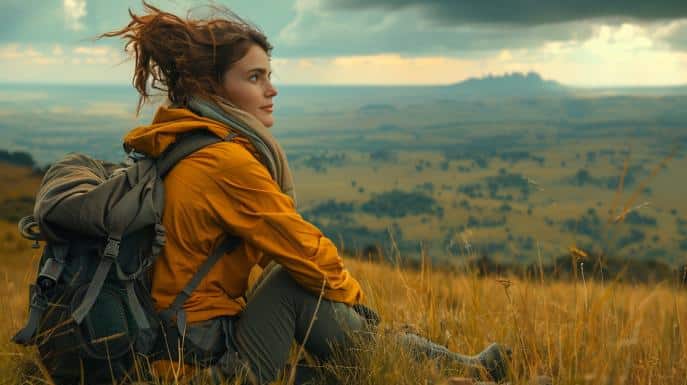Have you ever imagined being face to face with the wonders of wildlife, exploring the nuances of terrestrial ecosystems across the globe? In our new guide, '[Wildlife: A Guide to Responsible Farming]', we invite you to embark on this journey of discovery and connection. Discover the rich biodiversity that flourishes in different habitats, meet extraordinary animals and their adaptation strategies, and learn about the vital role of conservation. In this article, we not only map the wonders of the natural world, but also share how you can be a conscious traveler, ensuring future generations can enjoy them too. Ready to explore without leaving footprints? Let's go!
What are the main terrestrial ecosystems and their characteristics?
Major terrestrial ecosystems include tropical forests, savannas, deserts, tundra, and temperate forests. Each plays a fundamental role in sustaining wildlife, offering unique conditions that favor the existence of different species. For example, tropical forests are rich in biodiversity due to their humid and warm climate, while savannas are known for their large herbivores.
Natural habitats face significant challenges due to climate change and human intervention such as deforestation and pollution. These actions directly affect the connections between flora, fauna and climate in ecosystems. Understanding these connections is vital to protecting the delicate dynamics that sustain these habitats.
It is important to highlight the richness of life in the Amazon forests, which are home to more than 10 million life forms, the African savannas, which are home to the “Big Five”, and the Great Barrier coral reef, home to marine diversity extensive. Thus, recognizing the importance of each biome, we can protect wildlife by better understanding their characteristics and the challenges they face.
How does wildlife adapt to different habitats around the world?
Wildlife exhibits a fascinating ability to adapt to the most varied ecosystems, each animal developing unique strategies to survive in its natural habitat. From the polar bears' thick coat of fur, suited to insulating the extreme cold of the Arctic, to the chameleon's impressive camouflage capabilities, which allow it to blend into its surroundings and capture its prey, are examples of this incredible adaptability.
Behavioral strategies are also vital, such as migratory patterns that allow various species to move in search of resources or favorable climate. Furthermore, the specific reproductive biology of certain animals, which ensures the survival of offspring in adverse conditions, is also a fundamental adaptation.
The crucial role of endemic species for biodiversity stands out as one of the pillars that support the balance of ecosystems. They are essential for maintaining environmental health, fulfilling specific ecological functions. Endemic species are those found exclusively in certain locations on the planet, often islands or isolated regions, which makes them vital to the identity and complexity of each biome.
What are the main threats to wild animals and how does this affect their survival? The main threats include habitat destruction, climate change and illegal hunting. These factors not only reduce animal populations, but also affect biodiversity as a whole, disrupting food chains and ecological processes.
To the inspiring wildlife conservation stories show us how consistent efforts can generate positive results in the protection and recovery of species and their environments.
Conservation initiatives are critical to ensuring future generations can experience the incredible diversity of wildlife. At the same time, each individual can play a positive role by supporting these actions and practicing environmental awareness in their daily activities.
How important is wildlife conservation for the planet?
Wildlife conservation is critical to maintaining global ecological balance. Biodiversity loss affects all ecosystem functions that are vital to Earth's survival as a coherent, interconnected system. Healthy ecosystems provide essential services such as air and water purification, plant pollination, and climate regulation. Furthermore, species diversity is critical for medical research and food production, which are fundamental to human health and well-being.
On the global stage, there are several successful initiatives focused on preserving wildlife. Examples include species reintroduction projects, creation of ecological corridors and protected areas, which help ensure the survival of animals at risk and the maintenance of their natural habitats.
The individual contribution to the conservation of animals is equally relevant. Simple actions such as reducing the consumption of products linked to habitat destruction, supporting organizations dedicated to preserving species and engaging in conscious ecotourism practices are ways in which people can make a difference. Educating yourself about global wildlife through resources like online memory game, each can promote greater respect and care for wildlife.
In view of the above, it is clear that the preservation of the various forms of life and their habitats is essential. Through habitat conservation and species preservation, we not only protect the rich tapestry of life on Earth, but we also safeguard the health and continuity of the ecosystems on which we intrinsically depend.
How can we exploit wildlife responsibly?
Exploring wildlife can be unforgettable, but it is important to practice ecotourism and conservation consciously. Ecotourism promotes sustainability, educates tourists about conservation and supports the local economy. Your practices help maintain the biodiversity of natural habitats!
When observing wild animals, we must always maintain a safe distance so as not to disturb their natural behaviors or habitats. It is crucial to avoid feeding wild animals, as well as respecting the tranquility of the environment, not causing excessive noise or pollution.
Destinations such as African safaris are popular for wildlife viewing, but they must be explored ethically. Choosing tour operators that respect conservation guidelines and contribute to the protection of wildlife is essential.
Another example of responsible living is visiting protected areas and national parks that offer guided tours, where education and conservation meet. Experiences like these help us understand the connection between humans and nature and the implications of our actions on wildlife.
For even more inspiration about how your actions can contribute to wildlife conservation, read the inspiring wildlife conservation stories, where every effort makes a difference, teaching us about the importance of each species and the wonder of terrestrial and marine biodiversity. When we return home after such explorations, we take with us not only memories, but also a greater awareness of how to protect the precious beings with whom we share the planet.
As we delved into the complexity of terrestrial ecosystems, we saw how the diversity of biomes supports wildlife and how species adapt to diverse habitats. We face the reality of the challenges posed by climate change and human action. We also learned about the vital importance of conservation for maintaining our planet and concluded with a look at how we can interact with nature responsibly through ecotourism. These reflections not only highlight the richness and complexity of our Earth, but also reinforce our role in its preservation. Every step we take towards environmental awareness is an essential part of protecting ecological balance – a legacy that must last for future generations.
Frequently Asked Questions (FAQ)
What are the main terrestrial ecosystems?
The main terrestrial ecosystems are tropical forests, savannas, deserts, tundra and temperate forests. Each has distinct characteristics, such as the humid and hot climate of tropical forests, which promote rich biodiversity, and savannas, known for their large herbivores.
How do animals adapt to different ecosystems?
Animals adapt to different ecosystems through physical characteristics, such as polar bears' coat of fur for the cold, and behavioral strategies, such as migration in search of resources. Special reproductive behaviors also help the survival of offspring in adverse conditions.
What are the biggest threats to wildlife and their impact on biodiversity?
The biggest threats to wildlife include habitat destruction, climate change and illegal hunting. Such factors reduce animal populations and interfere with biodiversity, affecting food chains and ecological processes.
Why is it essential to conserve wildlife?
Conserving wildlife is essential for maintaining the balance of ecosystems, providing vital services such as air and water purification, and for human health. Species diversity is also important for medical research and food production. Individual and global initiatives in the conservation of species and their habitats promote a sustainable future.
How can we exploit wildlife responsibly?
To explore wildlife responsibly, we must practice sustainable ecotourism, maintain a safe distance from animals, avoid disturbing their natural habitats, and choose tour operators that follow conservation guidelines. Visits to protected areas and national parks provide opportunities to learn about wildlife while contributing to their protection.







